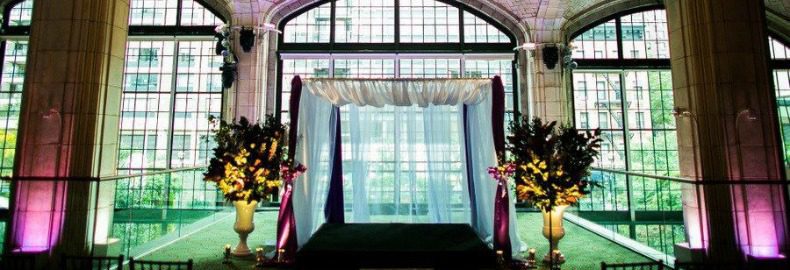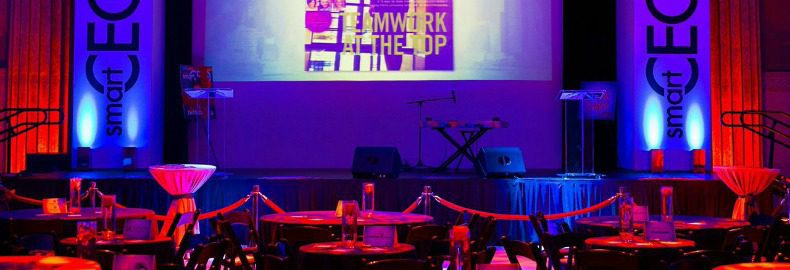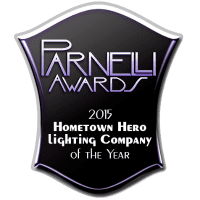Think about the last event you attended as a guest. What is it that you remember about that night that impressed you the most? It probably wasn’t the food or the flower arrangements, not even the music or dancing. What you most likely remember is the mood, the excitement, the environment and the energy! Well to be completely honest, what brought it all together was the spectacular event lighting!
Special event lighting can take a mundane event and turn it into a spectacle of lights, moods and otherworldly environments. The lighting designers who create these magical moods are highly knowledgeable, educated, and extremely creative tech-savvy individuals who have a grasp on what it takes to light a memorable event for your guests.
Let’s examine some of the factors that a lighting designer takes into account when creating and programming event lighting in a competitive market like New York City.
Event Lighting – Secrets of the Trade
A good lighting designer is equal parts technology nerd, creative artist, social psychologist and magician! They understand not only the technology needed to produce those special effects we all love, but how to time them and fit them into a series of cohesive and coordinated moments to build in emotional intensity over the course of several hours.
Their job begins the moment they are hired. They will visit the venue, make notes on equipment and capabilities, meet with the in-house production staff, speak with any artists that may be performing and begin the creative process of envisioning your event in the venue.
After their visit, they will begin to design the specific lighting for your event. Below are just a few factors they will consider as they begin the creative process.

Lighting Design – Gray Matter Visual
Style of the Event
Every event has its own personality, character and specific needs. Event lighting is never a “one size fits all” proposition. Lighting a rock concert requires a completely different approach, equipment and style than lighting a charity fundraiser. A good lighting designer knows what is appropriate and will approach each event creatively to maximize the impact for your guests.
They will also take into account your overall vision for your production. If you have separate rooms or areas for portions of your event, for example an awards presentation, they will design one environment for the stage, another for the lounge and a third for the seating area. All will be cohesive and connected, but each may have its own individual character and mood.
Audience Size, Age and Expectations
Your designer is working to set the correct mood for your event. They will take factors like audience size, age and expectations into account when designing your event lighting. An outdoor rock concert for 30,000 screaming music fans has completely different requirements than a warehouse rave party for 300 twenty something’s who are there to dance!
If your event is a charity ball and silent auction and your attendees are older, your designer will work to establish a classy, subdued mood, possibly focusing warm lighting on the tables of auction items. Each event has its own requirements and the experience and creativity of your lighting designer will lead them to create the perfect mood to fit any occasion.

Venue Space
Each venue will have unique and specific requirements which your designer will need to know to adapt their approach. The initial site visit will let them know what the venue has on hand. Some venues have complete lighting systems in place and your designer may be able to adapt the existing system to fit your creative vision. Other venues may have a system in place that will need to be supplemented with additional equipment. Still others may have very minimal to no lighting in place, and they will need to start from scratch Your designer will use this information when designing your event lighting plan.
Equipment Selection
A major part of developing a lighting plan includes selecting the right technology for the job.
The designer’s experience and knowledge of the technology drives the choices available to them. Again, the equipment choices will be reflective of the type of event, size of the event and needs of the venue.

Budget Restrictions
Of course, one of the major factors guiding any lighting design is the client’s budget. A large event with a large budget allows the lighting designer to get creative in their choices and design. However, a good designer can work within the limitations of any budget. Their knowledge of the capabilities of the venue and technology along with their creativity allows them to make magic with even a minimal amount of equipment.
Hiring and working with a professional technical event production company will make your event a night to remember. Creative, mood enhancing event lighting will create an environment that will touch your guests on an emotional level. A professional lighting designer can take your event from the mundane to the magical! Spectacular, cohesive, coordinated event lighting will have your guests talking about your event far into the future!







